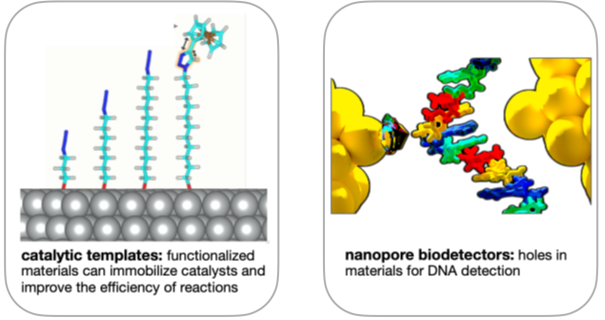NanoMLmatDesign: Computational design of complex materials: from nanopores to alloys
Project ID: NanoMLmatDesign
Introduction
An optimum and selective materials design based on computational approaches is essential in order to avoid time-consuming and expensive experiments and drive novel applications in sensing, catalysis, and electronic components. Within this concept, (a) the optimization of nanoporous materials made of functionalized gold surfaces with self-assembled monolayers, as well as (b) the design of alloying materials were investigated. The investigations are directed towards (a) heterocatalysis and biosensing, as well as (b) alloys for strong and highly conducting electronic components were seeked. This research was performed using quantum-mechanical and atomistic simulations occasionally in combination with Machine Learning approaches.
↵
| Principal investigator: | Prof. Maria Fyta, PhD |
| Project manager: | Prof. Maria Fyta, PhD |
| Researchers: | |
| Date published: | February 2025 |
| HPC platform used: | HoreKa |
| Institute: | Institute for Computational Physics |
| Affiliation: | University of Stuttgart |
| Research field: | Physics, Chemistry, Materials Science |
| Project ID: | NanoMLmatDesign |
Project description
The main goal of this project is to provide a computer assisted materials design for certain materials, such as porous structures and alloys. Porous structures refer to materials including holes of a few nanometers in size. Alloys are materials of a certain element that also include impurities of other elements. To this aim, quantum-mechanical calculations within the density functional theory (DFT) framework and atomistic Molecular Dynamics (MD) simulations are performed. These simulations are supplemented by Machine Learning schemes to either improve the efficiency of the simulations, through the concept of Machine-learned potentials (MLPs) or to assist the analysis. The computational modeling performed here is dedicated in improving materials for a three-fold goal: (a) unraveling the conditions and materials for improving chemical reactions, (b) improving materials for detecting the genetic code, and (c) designing better electronic components. The computations performed are of high demand and can be carried out only on a high-performance computing center utilizing a large number of computing processors and power at the same time.
In view of functional materials for heterocatalysis, the functionalization of gold templates with molecules of different sizes and types provided insight into the possibility of 'clicking' a catalytic molecule on these in order to improve catalytic reactions due to its immobilization on the templates. This immobilization could be probed through the inspection of the optical absorption of the templates. A similar approach was used to investigate the potential of oxide-based templates for the same purposes. As a further immobilization strategy, the functionalized silica nanopores were embedded in a bi-phasic solution that ensured a significant decrease of the mobility of catalytic molecules. The simulations could follow the dynamics of the latter and unravel the influence of the solvent environment in optimizing the catalytic conditions.
Another application of nanopore materials is biosensing, i.e. the detection of biomolecules, such as DNA, RNA, and proteins and their sequences. The detection is based on the ionic flow and/or the electronic current in the nanopore. The computer simulations allowed a thorough investigation of functionalized gold electrodes and two-dimensional ultra-thin materials and their potential in distinguishing among different types of biomolecules. The computational modeling provided essential information related to the direct interaction of the materials and the biomolecules, which in turn strongly influences the biosensitivity of the materials towards correctly detecting the target biomolecule. The assessment of the latter was based on the calculation of the electronic currents across the nanopores, their ability to distinguish among different DNA molecules, and the influence of the environment and dynamics of the molecules. The analysis could provide ideas for optimizing novel sensing devices.
Beyond these studies, the design and prediction of new materials with enhanced strength and electric conductivity was tackled by investigating the composition of various copper alloys, that is copper materials with impurities of different types, combinations, and concentrations. This resulted in the prediction of new materials, but at the same time, provided with accurate interaction models (MLPs) that were and can be used in follow up large-scale computational studies able to investigate the predicted materials and their properties in more detail. These can in turn provide more extensive details on material's properties and their applicability for certain purposes.

